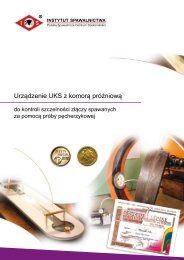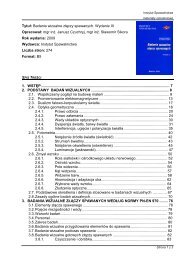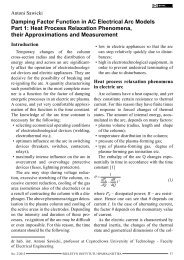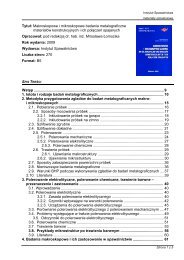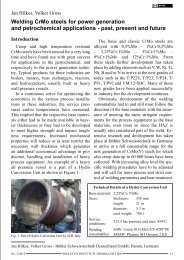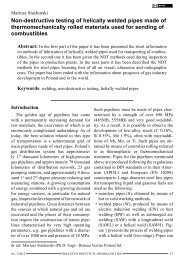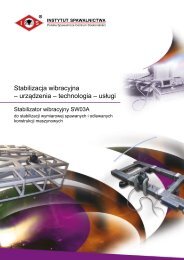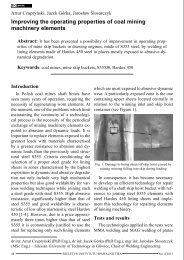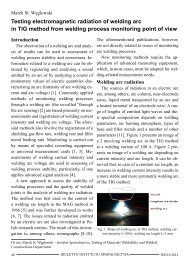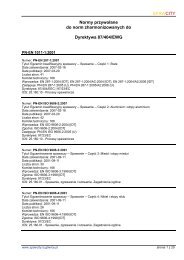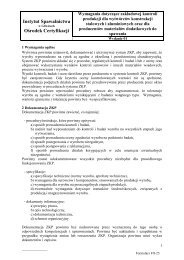Biuletyn Instytutu Spawalnictwa No. 01/2012
Biuletyn Instytutu Spawalnictwa No. 01/2012
Biuletyn Instytutu Spawalnictwa No. 01/2012
You also want an ePaper? Increase the reach of your titles
YUMPU automatically turns print PDFs into web optimized ePapers that Google loves.
On the basis of calculations (Tables 1 and 2)<br />
indicating that the sum of the least squares of<br />
deviations is the lowest for the generalised model<br />
and with taking into account the weight ΔB kl<br />
,<br />
equation (7) takes the final form as follows:<br />
0,02<br />
⎛ 1 ⎞<br />
0,0<strong>01</strong>7LI<br />
1,364<br />
I<br />
2<br />
Biv =<br />
⎜<br />
e − ⎟ − 0,000035I − 0,114<br />
⎜ 2 ⎟<br />
⎝ ⎠<br />
(8.4.1.2)<br />
The equation is satisfied when a wavelength<br />
amounts to 698 nm and a welding arc length is<br />
contained in a range 2 mm÷5 mm. A graphic illustration<br />
of the theoretical [6] and generalised<br />
models is presented in Figures 10 and 11. The<br />
tests were carried out for arc burning on a copper<br />
plate cooled with water.<br />
Fig. 10. Dependence of welding arc radiation intensity in TIG method on<br />
welding current intensity, for wavelength of 698 nm and arc length of 2 mm<br />
Fig. 11. Dependence of welding arc radiation intensity in TIG method on arc length<br />
L and welding current intensity, for wavelength of 698 nm and arc length of 2÷5 mm<br />
Summary<br />
The study presents the results of tests of welding<br />
arc radiation in TIG method. On the basis of<br />
the tests it was possible to come to the following<br />
conclusions:<br />
• in case of a constant welding arc length, an<br />
increase in welding current intensity leads to an<br />
increase in arc visible radiation intensity,<br />
• in TIG method an increase in an arc length<br />
causes an increase in welding arc visible radiation<br />
intensity,<br />
• determination of parameter values (G 1<br />
, G 2<br />
,<br />
G 3<br />
, G 4<br />
and γ) in the generalised semi-empirical<br />
model enabled better matching of a welding<br />
arc model for a 2÷5-mm range of welding<br />
arc lengths .<br />
On the basis of the test results<br />
it is possible to state that welding<br />
arc radiation is a source of rich information<br />
about a welding process<br />
course and makes a valuable tool<br />
in the monitoring of a TIG welding<br />
process. The tests indicate the<br />
possibility of using technologically<br />
advanced spectrophotometers in the<br />
monitoring of welding processes. If<br />
applied in combination with optical<br />
fibre lines, the spectrometers could<br />
enable the real-time control of arc-based<br />
welding processes (TIG,<br />
MIG/MAG, PAW) as well as, due<br />
to the presence of a plasma cloud<br />
during welding with a laser beam,<br />
also the monitoring of the latter<br />
process. It should be noted that a<br />
spectrophotometric card enables<br />
the monitoring of intensity changes<br />
of many spectral peaks at the same<br />
time and thus makes it possible to<br />
obtain more information about an<br />
object being tested.<br />
NR <strong>01</strong>/2<strong>01</strong>2<br />
BIULETYN INSTYTUTU SPAWALNICTWA<br />
51



